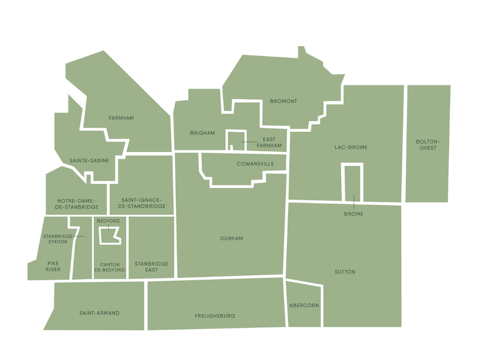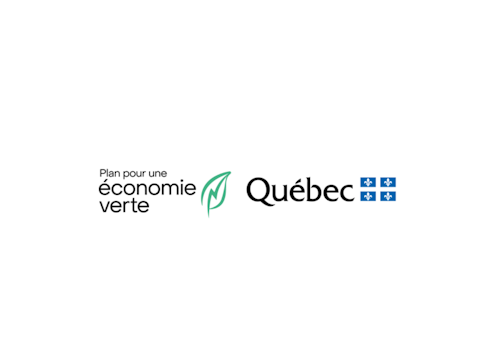
Climate plan
The Climate Plan is a land-use planning tool designed to reduce greenhouse gas (GHG) emissions and better prepare our communities for the impacts of climate change. This consultative project relies on the participation of citizens and local partners to build, together, a more resilient, low-carbon, and sustainable future.


Project phases

Why a Climate Plan?
We are already seeing the effects: extreme heat events are increasing, heavy rains are causing sudden floods, and droughts are affecting water supplies, crops, and ecosystems. In Brome-Missisquoi, roads have been damaged, rivers have overflowed, and some farming areas have suffered significant losses. These concrete realities push us to act.
By creating our Climate Plan, we are better preparing for the effects of climate change by identifying vulnerabilities and prioritizing the risks that the Brome-Missisquoi territory may face.
It is our way of protecting the environment while strengthening the resilience of our communities in the face of current and future climate challenges, all while reducing our carbon footprint.
By acting together at the Brome-Missisquoi scale, we can structure our investments more effectively, make informed choices for land-use planning, sustainable mobility, stormwater management, and water supply. Most importantly, we can bring citizens, businesses, and partners together around a common vision: a low-carbon, more resilient future.
Acting now also means saving money in the future and accessing essential funding to make our projects a reality.
Moving toward a Climate Plan in Brome-Missisquoi
For several years, the Brome-Missisquoi RCM has been planning and ensuring the harmonious and sustainable development of the territory. Faced with the urgency of acting on climate challenges, the RCM is taking a major step forward by initiating its very first Climate Plan.
This structuring project is made possible thanks to $1,326,058 in financial support from the Government of Quebec, under the Local Climate Transition Acceleration (ATCL) program, part of the 2030 Plan for a Green Economy (PEV 2030).
The plan will primarily address two closely related issues:
- Reducing greenhouse gas (GHG) emissions in the territory (Mitigation),
- Strengthening the resilience of communities to the effects of climate disruptions (Adaptation).
At the Council of Mayors’ meeting on September 16, the elected officials adopted the statement of intent (French only) of this first Climate Plan for Brome-Missisquoi RCM.
By positioning itself as a regional leader and mobilizing partners around collective changes, the RCM aims to accelerate the ecological transition while improving the safety and quality of life of all its citizens.
What do we mean by climate change?
The “ClimateData.ca” portal, supported by Environment and Climate Change Canada (ECCC) and the Canadian Centre for Climate Services (CCCS), defines climate change as:
“Alterations in average and extreme weather conditions, as well as variability, that persist over a long period of time, usually decades or more. Climate change leads to long-term increases in global temperatures and sea levels, as well as changes in the intensity and frequency of certain extreme events such as storms and wildfires.”
Source: ClimateData.ca
Learn more: https://climatedata.ca/resourc...
Building a Common Lexicon
Climate Change Mitigation: All actions aimed at limiting climate change, mainly by reducing GHG emissions at the source and/or increasing carbon sequestration (e.g., forests, wetlands).
Examples of existing measures and plans contributing to mitigation:
Climate Change Adaptation: Actions aimed at limiting the negative impacts of climate change and/or taking advantage of emerging opportunities.
Examples of existing measures and plans contributing to adaptation:
-
Farnham’s Heat Island and Heavy Rainfall Adaptation Plan (French only)
-
Water Management Climate Adaptation Process (ACCGE), e.g., Bedford, Cowansville
Climate Hazards: Climate-related events that may cause loss of life, health and safety impacts, infrastructure and property damage, social and economic disruption, or environmental degradation. Hazards can occur gradually or suddenly (e.g., floods, heatwaves, droughts).
Climate Transition: The transformation of society and its economy to stop contributing to climate change and become resilient to its effects.
Example of an existing plan contributing to adaptation:
What is a Climate plan?
The Climate Plan is a toolbox that identifies climate risks in the territory and defines priorities to reduce GHG emissions and adapt to climate change.
Adapted to the realities and specific needs of Brome-Missisquoi’s municipalities, the Climate Plan becomes our roadmap for the next 5 to 10 years. It acts as a lever for action, an investment plan, and a framework for collaboration, all toward a sustainable ecological transition.
A Lever for Regional Sustainable Development
This Climate Plan initiative directly continues the Brome-Missisquoi 2024–2034 Territorial Strategic Sustainable Development Plan, which highlights the protection and resilience of the territory and its resources in a context of climate change.
The Climate Plan will reinforce this shared vision by actively contributing to several objectives of the Strategic Plan, including projects 1.5.2, 2.1.4, 2.1.5, 3.4.3
A consultative approach
To ensure the Climate Plan reflects the concerns and issues of key stakeholders and the population, a consultation process with various partners and public engagement activities will take place throughout its development.
The Brome-Missisquoi RCM wants the climate transition to happen with and for all its communities. It’s like walking together toward a new destination: we move forward better if everyone is well equipped.
The goal: to make the transition easier, fairer, and more inclusive, ensuring that no one is left behind in building a more resilient, low-carbon, and sustainable future.


A territorial diagnostic
To ground the Climate Plan in Brome-Missisquoi’s reality, we must establish a portrait of our territory (administration, geography, population, economy, regulations).
The portrait also describes the current climate situation of the territory under two main themes:
-
GHG emissions inventory,
-
Identification of priority climate risks in Brome-Missisquoi.
This diagnostic allows us to set a climate vision and objectives. It defines our 5- to 10-year targets for climate adaptation and GHG reduction in order to plan mitigation and adaptation measures for collective implementation.
(Additional info available: GHG inventories and climate risk prioritization per Ouranos).
The Climate Situation of the Territory Includes:
1. A Greenhouse Gas (GHG) Emissions Inventory:
To effectively fight climate change, we must first understand where our GHG emissions come from. We will prepare a portrait of what generates GHG emissions within our territory, namely:
-
A municipal inventory (21 municipalities and the RCM): municipal buildings and other facilities, vehicles and motorized equipment, wastewater treatment;
-
A community-wide inventory in Brome-Missisquoi: homes, businesses, industries, road transport, and community waste management.
2. Identification of Priority Climate Risks in Brome-Missisquoi
The adaptation approach is based on this analysis of risks linked to the impacts of climate change. It aims to identify region-specific risks to public infrastructure (e.g., roads, buildings), the population, municipal services, and more.
According to Ouranos, a risk is defined as the potential consequences resulting from the exposure of a vulnerable human or natural system to a climate hazard (e.g., floods, heatwaves, droughts, etc.).
By “consequences,” we mean harm, damage, or benefits for the natural and human systems affected by the occurrence of a hazard.
Source: IPCC, AR5 Climate Change 2014: Impacts, Adaptation and Vulnerability
In short, this key step serves to prioritize the risks that the territory of Brome-Missisquoi may face.
For more information on this stage of climate risk assessment, visit the Ouranos website:
https://www.ouranos.ca/en/adaptation-risk-assessment
Strategy and action plan
Based on the climate vision and objectives, the plan will identify concrete measures and priority projects to be implemented in the RCM within the next 5 to 10 years.
An action plan will be developed by:
- Identifying GHG reduction actions using the “avoid, reduce, sequester” approach (e.g., transport, building insulation and energy use, waste management – mitigation measures);
- Prioritizing adaptation measures suited to the territory (e.g., flood prevention, protection against heatwaves – adaptation measures);
- Integrating awareness-raising, mobilization, and regulatory adjustments to facilitate the climate transition (support measures).
To ensure collective implementation, each measure will be detailed with responsibilities, timelines, costs, and monitoring indicators.
For more information on climate change adaptation solutions, visit the Ouranos website: https://www.ouranos.ca/en/video-capsules/solutions-in-action.
Image credit below: Sources: Ouranos and MELCCFP (2024)

Videos
How will climate change affect Quebec in the coming years? (Video produced by Ouranos)
What does it mean to adapt to climate change? (Video produced by Ouranos)
Useful links and documents
Territorial sustainable development strategic plan of the Brome-Missisquoi (2024-2024)
Consult the Territorial sustainable development strategic plan of the Brome-Missisquoi.

Partners
The Climate Plan is made possible thanks to the financial support of the Government of Quebec under the Local Climate Transition Acceleration program, part of the 2030 Plan for a Green Economy.
Contact persons


Valérie-Anne Bachand
Sustainable land management coordinator

Philippe Lavallée
Socioecological Transition coordinator
